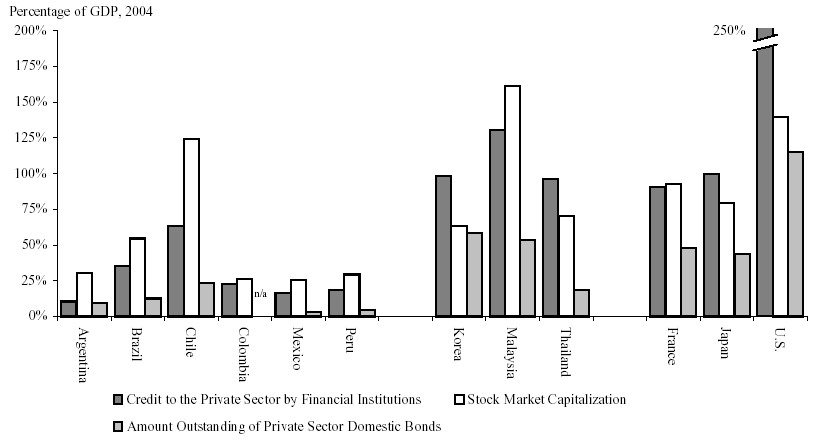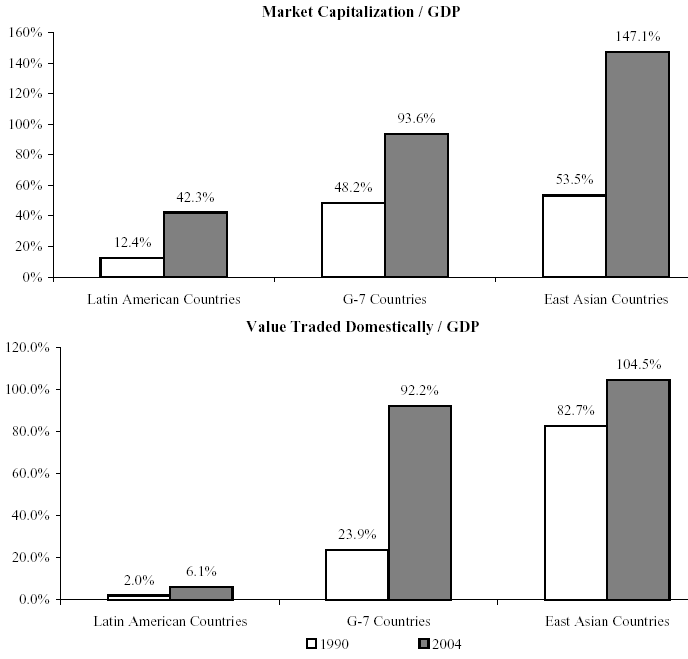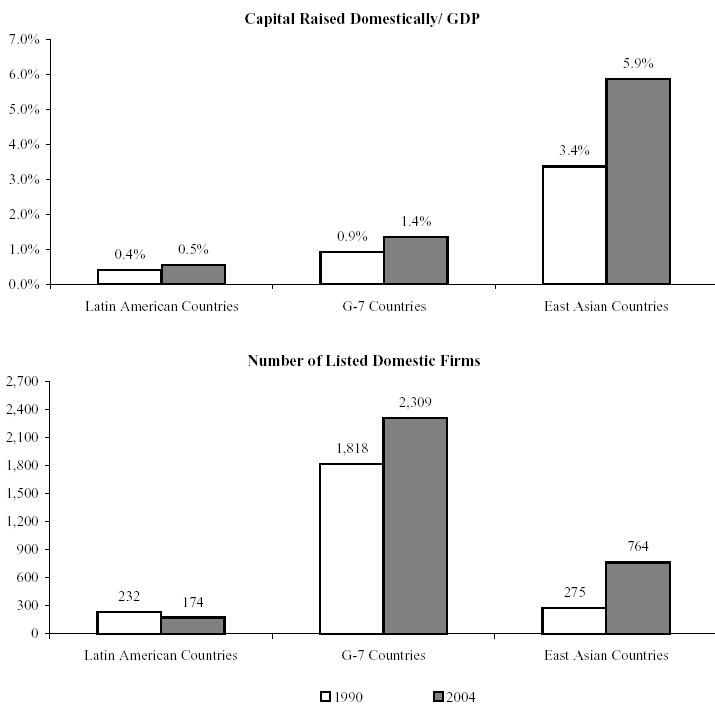Introduction
The economic health of a nation or a community can be gauged by various indicators, and some of them are GDP, inflation, turnover, and the performance of the capital markets. This paper discusses the research question that is made of two parts. The first is ‘Do capital markets foster economic development. The other question is a ‘comparison of the Latin American economies with East Asian again with reference to the capital markets. The paper would first establish a link between capital market and economic development and then attempt to analyze statistics between these two regions.
The link between capital market and economic development
Chinn (2005) has examined in detail the links between the financial liberalization of a region and its economic and financial development. The author asserts that to a great extent when capital account and markets are liberalized, the process can help to boost the economy of a region (p. 2). The argument used by the authors is that when an economy is liberalized, it provides finance and funds that borrowers can utilize to set up ventures and make their businesses grow, thus leading to the growth of financial markets.
The authors point out that when the capital account is liberalized, it can lead to the development of financial systems through several channels. Some of the channels used are financial liberalization may mitigate financial repression in protected financial markets, allowing the real interest rate to rise to its competitive market equilibrium. When capital controls are removed, this provides local as well as foreign investors to enter the market and diversify their portfolios.
These two, in turn, can result in a financial liberalization that can reduce the cost of capital and increasing its availability for the borrowers. Financial globalization reduces the cost of equity capital because of the reduction in the expected returns to compensate for risk as well as in agency costs. The liberalization process usually increases the efficiency level of the financial system by weeding out inefficient financial institutions and creating greater pressure for a reform of the financial infrastructure. Such an improvement in financial infrastructure may alleviate information asymmetry, decreasing adverse selection and moral hazard, and further, raise the availability of credit (p. 2-4).
Again Chinn (p. 5) points out that the prospect of financial liberalization, in turn, can lead to some unforeseen hazards, and some elements of higher risks are introduced when a closed environment is suddenly opened, and new non-local investors rush in. The authors suggest that in economies where the legal system does not clearly define property rights or guarantee the enforcement of contracts, the incentives for loan activities can be limited.
Legal protections for creditors and the level of credibility and transparency of accounting rules are also likely to affect economic agents’ financial decisions. Further, the authors point out that low levels of shareholder rights are associated with poorly developed equity markets, especially in French civil law countries. In contrast, Common law countries have high levels of shareholder rights with correspondingly high levels of equity market development, and that greater creditor rights are positively associated with intermediary financial development (Chinn, p. 12).
Chinn (p. 18-21) has suggested that financial openness will contribute to equity market development, but only when a threshold level of the general development of legal systems and institutions has been attained. Financial development, when measured as activity of the stock market, appears to depend upon capital account openness both individually and in interaction with the level of legal development. The general level of legal development matters more than the level of finance-specific legal/institutional development.
Summary
The summary of the discussion in this section is: capital markets and their development to a great extent influence and drive the economy. For capital markets to grow, there need to be effective legal recourses, political stability, and a stable infrastructure to ensure that all contractual and financial obligations are met by the borrowers. Only when such a system is in place can the region be called stable and open and will attract investors.
Latin American and East Asian Regions Economic Growth
Augusto (2006) has researched the capital markets of Latin American countries, and the authors suggest that in the past decades, Latin American countries did take up some measures of reforms to boost the economy, and this included lending support for the capital market. The authors have affirmed that in spite of these reform efforts, capital markets in Latin America still remain underdeveloped when compared to markets in other regions such as East Asia.
The stock markets in these regions remain below the levels of Dow Jones and other indices. It has also been pointed out that these countries have ample natural resources in the form of crude oil, vast farmlands, and minerals. But the economic growth of these countries has been still low, and there is a direct link between the lack of growth in capital markets and economic growth. The observed lack of capital market development in Latin America may be a consequence of the region’s poor fundamentals, suggesting the need to push further ahead in the reform effort to achieve a higher level of economic and institutional development, which in turn should result in more developed capital markets. (Augusto, p. 4).
The rest of the paper will produce empirical evidence to show the growth of capital markets and the economy in Latin American countries and East Asian countries. Please refer to the following graph that gives details of the credit to the private sector by financial institutions over GDP, domestic stock market capitalization over GDP, and the amount outstanding of private sector domestic bonds over the GDP at year-end 2004 for the selected countries.

The above graph shows different indicators of financial development for selected Latin American, East Asian, and developed countries, and the figure presents data on credit to the private sector by financial institutions, stock market capitalization, and the amount outstanding of private sector domestic bonds, all as a percentage of Gross Domestic Product (GDP), at year-end 2004. As seen in the figure, although there are small differences among Latin American countries, most countries in the region have significantly smaller financial markets than G-7 and East Asian countries.
Chile is the only exception, as the size of its financial markets, especially its stock market, vastly exceeds that of other Latin American countries and also compares favorably with financial markets in developed and East Asian countries. However, analyzing measures of actual stock market activity, such as value traded, shows that Chile’s stock market remains underdeveloped compared to markets in East Asia and developed countries (Augusto, p. 7).
Please refer to the following graphs that give figures for two indicators: market capitalization versus GDP and value traded domestically and the GDP.

The above graph shows market capitalization over GDP and value traded domestically over GDP. The series are averages across countries. The data for G-7 countries are averages for Canada, France, Germany, Italy, Japan, United Kingdom, and the United States. The data for East Asian countries are averages for Hong Kong, Indonesia, Korea, Malaysia, Philippines, Taiwan, and Thailand. The data for Latin American countries are averages for Argentina, Brazil, Chile, Colombia, Mexico, Peru, and Venezuela. As seen in the graph, over the last decades, stock markets in Latin America have grown considerably.
The average domestic stock market capitalization in terms of GDP in the seven largest markets in the region (Argentina, Brazil, Chile, Colombia, Mexico, Peru, and Venezuela) more than tripled between 1990 and 2004. Value traded in domestic stock markets also increased significantly during this period, from an average of 2.0 percent of GDP in 1990 to 6.1 percent in 2004. Despite this strong growth, stock markets in Latin America are still small when compared to those in other regions.
At the end of 2004, stock market capitalization in this region reached 42.3 percent of GDP, compared to 93.6 and 147.1 percent in G-7 and East Asian countries, respectively. Latin American countries seem to be caught in a low liquidity trap. While value traded in domestic stock markets stood at 6.1 of GDP in Latin America in 2004, it reached 92.2 percent in G-7 countries and 104.5 percent in East Asia (Augusto, p. 8).
Another graph gives details of capital raised over GDP and the number of listed domestic firms in the regions of Latin America, East Asia, and G7 countries. Regional differences can be observed when analyzing capital raising activity. Capital raised as a percentage of GDP in Latin American stock markets is lower than in other regions, reaching 0.5 percent in 2004, compared to 1.5 percent in G-7 countries and 5.9 percent in East Asia. The average number of firms listed in domestic stock markets in Latin America has decreased over the last decades, from 232 in 1990 to 174 in 2004. This reduction stands in contrast to the increase in the number of listings experienced by both G-7 and East Asian countries during this period (Augusto, p. 9).

Summary
The section has shown an empirical relation to the GDP and the capital market in three regions: Latin America, G 7 countries, and East Asian countries. Other indicators that have been examined include the capital-related domestically with GDP, and while the value for East Asia is 5.9 %, the value for Latin America is o.5 percent.
Conclusion and Findings
The paper first proved that there is a definite link between capital markets the economic growth, and their development to a great extent influence and drive the economy. For capital markets to grow, there need to be effective legal recourses, political stability, and a stable infrastructure to ensure that all contractual and financial obligations are met by the borrowers.
The findings show that East Asian countries have a much stronger and growing economy, and this is directly related to the growth of capital markets. Latin American countries have a lower GDP, and the capital market is much lower than East Asian countries.
References
Augusto de la Torre, Juan Carlos Gozzi. 2006. Capital Market Development: Whither Latin America? Web.
Chinn Menzie D., Ito Hiro. 2005. What Matters for Financial Development? Capital Controls, Institutions, and Interactions. Web.